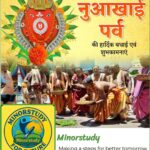🌟 Introduction
India is a land where every grain, drop of water, and ray of sunshine is seen as a blessing of the divine. Our festivals are not just dates on the calendar; they are celebrations of life, gratitude, and harmony. One such vibrant and meaningful festival is the Nuakhai Festival, celebrated with great enthusiasm in Odisha and neighboring states.
- 🌟 Introduction
- 🌾 What is Nuakhai Festival?
- 🏛️ History of Nuakhai Festival
- 📜 Timeline of Nuakhai
- ✅ Significance of Nuakhai Festival
- 🪔 Rituals & Observance of Nuakhai
- 🌍 Daily Life Impacts of Nuakhai
- 📊 Interesting Facts About Nuakhai
- 💌 Wishing Messages for Nuakhai
- 📌 Important Points
- ❓ FAQs
- 🏆 Importance in Our Life & Society
- 📝 Conclusion
“Nuakhai” literally means eating the new crop. It is a festival of farmers, food, and family unity, where people thank Mother Earth, deities, and nature for a bountiful harvest. More than just eating new rice, Nuakhai is about gratitude, togetherness, and cultural pride.
In this article, we’ll explore Nuakhai Festival in detail—its history, facts, timeline, significance, observance, wishing messages, FAQs, daily life impact, and importance in society. By the end, you’ll realize why this humble yet grand festival has such a powerful influence on our daily lives and community bonds.
🌾 What is Nuakhai Festival?
The word “Nuakhai” comes from two Odia words:
Nua = new
Khai = food/eating
So, Nuakhai means eating new rice after offering it to the divine.
Primarily celebrated in Western Odisha (Sambalpur, Balangir, Bargarh, Kalahandi, Nuapada, Sonepur), Nuakhai is the most important harvest festival of the region. The festival involves:
Offering the new crop (rice) to Maa Samaleswari, the presiding deity of Sambalpur.
Family meals with dishes made from freshly harvested paddy.
Community celebrations with folk songs, Sambalpuri dance, and cultural performances.
It is not just a religious festival but also a social and cultural movement of unity.
🏛️ History of Nuakhai Festival
The tradition of Nuakhai dates back to ancient agrarian societies. Its history can be understood in different phases:
Prehistoric & Tribal Roots
Tribal communities believed that the first produce must always be offered to the nature gods before consumption.
It symbolized respect for food and nature.
Vedic Period (1500–500 BCE)
References in ancient texts like the Rigveda mention offerings of the first grains (Pratyabhinandana) to deities.
The tradition of first eating (navanna) was widespread across India.
Medieval Odisha
The rulers of Sambalpur and surrounding regions institutionalized Nuakhai as an official community festival.
Maa Samaleswari became the central deity of worship.
Modern Era
Today, Nuakhai is celebrated not only in Odisha but also in Chhattisgarh, Jharkhand, Bihar, and Madhya Pradesh.
It has grown into a festival of identity, culture, and unity for Odias across the world.
📜 Timeline of Nuakhai
Ancient Era: First-eating rituals in tribal and Vedic societies.
Medieval Times: Institutionalization under local kings of Odisha.
19th–20th Century: Became a festival of agrarian pride in Sambalpur region.
Post-Independence India: Recognized as a major cultural festival of Odisha.
21st Century: Celebrated globally by Odia communities with cultural programs.
✅ Significance of Nuakhai Festival
Gratitude to Mother Earth: Reminds us to thank nature before enjoying her gifts.
Respect for Farmers: Recognizes the hard work and struggles of cultivators.
Unity in Diversity: Celebrated across communities, transcending religion and caste.
Cultural Identity: Preserves Odia heritage, songs, dance, and rituals.
Food as Sacred: Teaches us that food is divine and should not be wasted.
Spiritual Connection: Links everyday life with prayers and blessings.
Family Reunion: Strengthens family bonds through shared meals.
Social Harmony: Brings villages and communities together in celebration.
Sustainable Values: Encourages mindful farming and eating practices.
Emotional Well-being: Spreads happiness, positivity, and peace.
🪔 Rituals & Observance of Nuakhai
Preparations
Cleaning homes, courtyards, and kitchens.
Collecting ingredients from the newly harvested crop.
On the Festival Day
Offering to Deity
The new rice (Nabanna) is offered first to Maa Samaleswari or local deities.
Special prayers are performed for prosperity and protection.
Family Feast
Traditional dishes like Pakhala, Pitha, Khichdi, Kheer, and Saga Bhaja are prepared.
Families eat together after offering to the goddess.
Community Celebration
Villages organize Nuakhai Juhar, cultural shows, folk dances, and dramas.
People greet each other warmly with “Nuakhai Juhar.”
Blessings for Farmers
Prayers are offered for rain, fertile soil, and successful harvests.
🌍 Daily Life Impacts of Nuakhai
Promotes Gratitude: Teaches us to value food and farmers.
Strengthens Families: Shared meals revive love and unity.
Encourages Simplicity: Reminds us to live close to nature.
Reduces Stress: Joyful celebrations boost mental health.
Preserves Heritage: Keeps folk songs, dances, and Sambalpuri culture alive.
Inspires Sustainability: Encourages respect for natural resources.
📊 Interesting Facts About Nuakhai
Nuakhai falls a day after Ganesh Chaturthi in the Bhadraba month (August–September).
The traditional greeting is “Nuakhai Juhar”.
It is considered inauspicious to eat the new rice before offering it to the deity.
Similar harvest festivals are celebrated across India:
Onam (Kerala)
Nabanna (West Bengal)
Makar Sankranti (North India)
Nuakhai Juhar (Chhattisgarh)
Nuakhai is not just an Odia festival—it is a universal celebration of gratitude for food.
💌 Wishing Messages for Nuakhai
🌾 “Nuakhai Juhar! May Maa Samaleswari bless your life with prosperity, peace, and joy.”
✨ “On this Nuakhai, let us remember to thank farmers and nature for every grain we eat.”
🥘 “Wishing you and your family happiness, health, and abundance this Nuakhai Festival.”
🌟 “Nuakhai is about gratitude and unity—may it bring harmony into your life.”
📌 Important Points
Nuakhai = New + Food (first eating of new rice).
Main festival of Western Odisha.
Associated with Maa Samaleswari.
Rituals include offering new rice, family meals, cultural programs.
Traditional greeting: Nuakhai Juhar.
❓ FAQs
Q1. Why is Nuakhai celebrated?
To thank nature, gods, and farmers for the new harvest.
Q2. Which goddess is associated with Nuakhai?
Maa Samaleswari, the presiding deity of Sambalpur.
Q3. Is Nuakhai only for farmers?
No, it is celebrated by all communities as a festival of gratitude.
Q4. When is Nuakhai celebrated?
On the fifth day (Panchami) of Bhadraba month, a day after Ganesh Chaturthi.
Q5. What is the main greeting of Nuakhai?
“Nuakhai Juhar,” meaning respectful greetings on Nuakhai.
🏆 Importance in Our Life & Society
Family Unity: Encourages togetherness through shared meals.
Cultural Preservation: Protects traditional Odia rituals and folk culture.
Social Equality: All communities celebrate together, reducing social barriers.
Mindful Living: Promotes gratitude, respect for farmers, and sustainable food habits.
Community Strength: Villages come together for collective joy and bonding.
📝 Conclusion
The Nuakhai Festival is more than just a harvest celebration—it is a festival of gratitude, unity, and humanity. It reminds us that food is sacred, farmers are our real heroes, and nature must always be respected.
In today’s fast-paced world, Nuakhai teaches timeless values:
Be grateful for what you have.
Respect the food on your plate.
Celebrate life with family and community.
So, the next time you say “Nuakhai Juhar,” let it not just be a greeting but a heartfelt reminder of the deep connection between humans, nature, and the divine cycle of life.









I love your writing style genuinely enjoying this site.
Can you be more specific about the content of your article? After reading it, I still have some doubts. Hope you can help me.